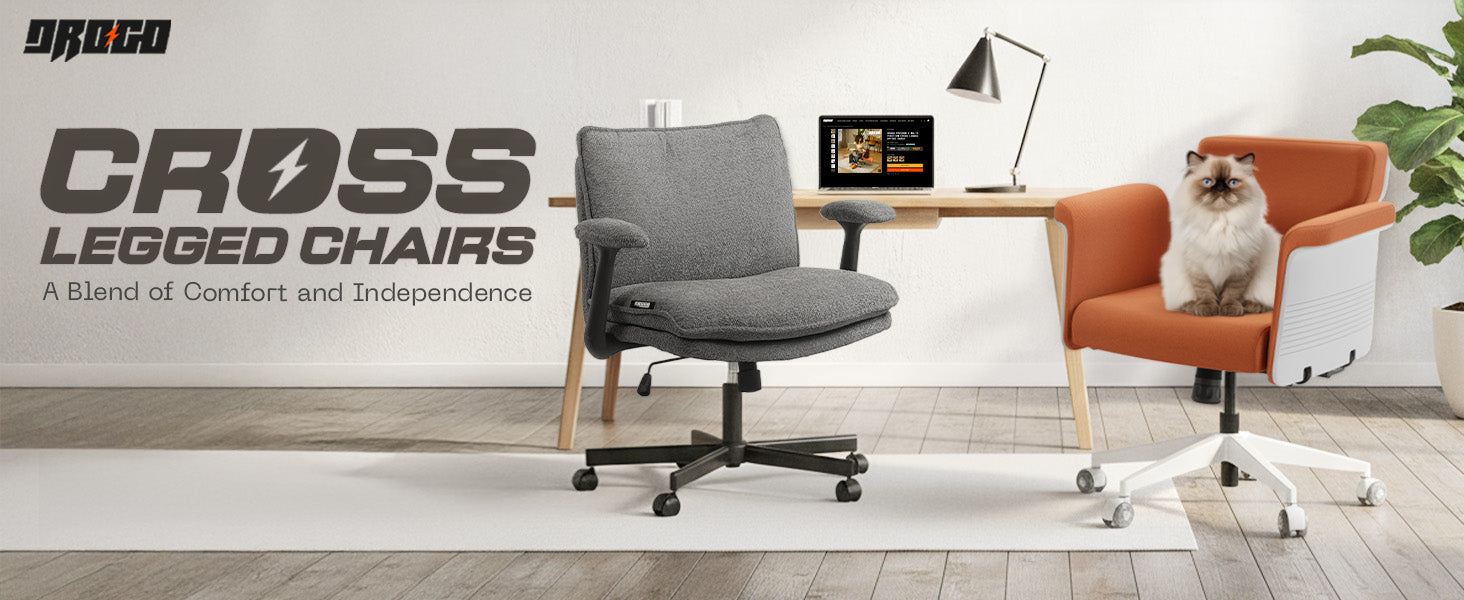Choose the seat, but choose carefully.
Have you ever wondered how many hours a day you spend just sitting?
In fact, sitting is our main daily activity which we carry out through different places such as our houses, offices, or even leisure time through the screen. But few of us actually think of how we are doing these things on a daily basis.
The problem is that how you sit can have a significant impact on the health of your spine. Long-term spine problems, weariness, and back discomfort can all be progressively brought on by the incorrect workplace chair. The correct one, though? It can go a long way to changing not only your feeling, and level of ease, but also the amount of your work output.
The Silent Strain: How Sitting Affects the Spine
The Silent Strain: How Sitting Affects the Spine
Being sedentary for hours at a time was not meant for the human being. The spine is designed for movement and mobility, and our natural "S" curve is better supported when we take moving breaks, and not when remaining stoically seated. For each hour sitting, the "S" curve *flattens,* especially with the use of poor posture and unsustaining chair supports.
This results in:
1. Compressed spinal discs that hurt or hurt all the time.
2. Weak glutes and tight hip flexors can make your lower back unstable.
3. Head forward and rounded shoulders can result in headaches and stiffness in the neck.
4. Musculoskeletal disorders (MSDS) can develop over time, and are one of the main causes of absence and lack of productivity in modern workplaces.
Overall, sitting positions can now decide how your spine will feel in ten years.
What Your Chair Should Support: The Anatomy of Good Sitting
A decent office chair is an ergonomic engineering marvel that supports the natural alignment of your body, not merely for its comfort. Let's examine what constitutes a genuinely spine-friendly chair:
1. Lumbar Support: The Best Friend of the Spine
When seated, the majority of your body weight is supported by your lumbar region, or lower back. The natural inward curve of the spine is preserved by a chair with lumbar support that may be adjusted. Your back sags without it, which puts a great deal of strain on your discs.
Tip: Look for chairs that allow adjustments in both height as well as depth of the lumbar support. The lumbar support should fit snugly into the lumbar region of your back; this is not a "prominent press," but rather a puzzle piece fitting snugly to your back.
2. Seat depth/height: where the comfort begins
You should be able to keep your knees comfortably at a 90 degree angle and plant your feet on the floor. If your seat is too low, your knees will be at an unpleasant height, and if too high, your legs will slowly reduce blood circulation to the legs.
The backs of your knees should be about two to three fingers away from the edge of your seat. Such a small gap allows your legs to have the right blood circulation.
3. The Silent Heroes: Adjustable Armrests
You underestimate the weight of your arms! The pain of the upper part of the back and the shoulders may be caused by the lack of support for the arms. The use of adjustable armrests that allow you to maintain your elbows at a 90 degree angle not only relieves that stress, but will also stop the cycle with poor posture.
In addition, they recommend keeping the wrists in a neutral position as you write to reduce the risk of repetitive stress damage such as carpal tunnel syndrome.
4. The Posture Keeper: The Backrest
The backrest of the chair has to be one step ahead and adjust to your spinal cord when you reposition yourself. Through these gadgets, you are allowed to shift your stance and not feel that the blood flow is hindered, as well as maintain the natural curvature of your spine. Such devices as dynamic or tilt-tension make the body-balance possible and hence, keep the blood flowing normally.
5. Softness and Breathability
Comfortability is not only a matter of softness. Chairs for offices of high quality use air-permeable foams or meshes in order to avoid the rise of the temperature and offer continuous comfort. Whereas the softening of the cushions may make the user feel enveloped at the very first moment, in fact, they are forcing the body to sink, thus impairing the correct posture.
6. Stability and Mobility
If properly designed, a chair will support your movements and not hinder you. A strong base with 5 points and smooth casters allows for easy mobility and helps keep you balanced. In this way, you can avoid unnecessary twisting or overreaching that can place a strain on your spine.
How Bad Chairs Lead to Posture Issues
The issue of badly constructed office chairs is that you might not immediately notice the damage. Using a chair that is not properly designed to support your spine for a long time could lead to a number of physical issues that may affect your health and activity level.
Lower back pain-
One of the main reasons for lower back pain that is commonly associated with it is the persistent lower back pain. Not giving the back area enough support will cause it to sink or curve outwards, and along with that the spinal discs will be constantly stretched. The situation can provoke some of the patients with sciatica or herniated discs to give off more intense symptoms and also be annoying.
Tightness in the neck and shoulder muscles -
A forward head posture most likely results in the formation of tight neck and shoulder muscles. The change of the head location and its being forward is actually pulling the neck and shoulder muscles to be constantly under tension and trying to support the forward head posture, and this tension, stiffness, and head discomfort may evolve. This tension and lack of movement may last for a while, months, or even years.
Improper circulation in the legs-
Another unintentional consequence is improper circulation in the legs. Sitting in a chair that puts too much pressure on your legs or forces your knees to dig in at awkward angles can restrict blood flow. When you sit for a long time without moving your legs, you can develop numbness and swelling and in rare cases, you may even increase your risk for deep vein thrombosis or varicose veins.
Tiredness and loss of focus-
The effects of tiredness and loss of focus are minimal yet significant. Bad posture causes muscles to work even harder to maintain equilibrium, which in turn, tires you out faster. The pain can also distract you from your tasks, which then decreases productivity and affects your ability to focus on your work.
The consequences of a poorly constructed chair were quantified in a study by Cornell University that showed that sitting in a chair with poor ergonomics could increase tension in your spine by as much as 50% compared to standing.
First of all, a chair with enough back support should not be considered a luxury; it is something that you need if you want to live healthily for a long time. A change of this nature, one that will give you relief and be a source of discomfort and pain for many years, is something that you can always make, no matter how late it is.
The ergonomic revolution: Revolutionary design of modern office chairs
Traditional office chair designs have been greatly surpassed by modern ones. Human-centered design, which integrates comfort, technology, and science, is used in the construction of the latest generation of ergonomic seats.
The following innovations are altering the way we sit:
1. Technology for Dynamic Sitting
Modern, high-end seats encourage movement even when seated. Your muscles stay active with features like auto-balance reclining, adaptable backrests, and synchronized tilt.
2. Memory Foam and Pressure Relief Design
The best chairs on the market have multi-layer foam that molds to your body shape, which in turn removes the pressure from the most sensitive parts of your body, like your legs and lower back.
3. Armrests in 3D or 4D
The features of these armrests allow the customer to change the position (up-down, in-out, forward-backward, and rotation) in a way most suitable for him/her. As an example, typing and phone use are two of the easiest works to be done with the right posture using these armrests.
4. Breathable and Eco-Friendly Fabrics
Most of the businesses these days put their money into the production of mesh that is easy to breathe through and comfortable to sit on, and which is also good for the environment.
A Complete Guide to Choosing an Office Chair
Often a marketing language might be deceptive, however, it is not always true that one office chair is better for your spine and posture than the other. First of all, you need to know what a healthy seated position is in order to check your chair will help you keep the right posture;
Step 1: Identify Seated Position
Do you spend most of your work time at the desk where you have to sit?
Did you ask yourself if you tend to sit down, move and multitask at the same time?
Would you be more comfortable sitting down or straight?
The type of chair becomes an easy decision when you have found the most comfortable way of sitting – a task chair, executive chair, or ergonomic mesh chairs.
Step 2: Try a Chair Before Buying
Based on the decision to buy a chair, testing it for 10 minutes to check the fitness is a really good idea. After you make adjustments for the height of the seat, armrests and lumbar support, you need to 'check your body' thoroughly.
The feet need to be in a comfortable and natural position on the floor, the shoulders should be in a relaxed state and the lower back supported.
Step 3: Know the different adjustment features
Each human body is unique. A chair that is more adjustable will probably be better that fits your body shape precisely
. Look for:
-
Adjustable lumbar support seat depth and height adjustability.
-
Armrests with multiple directions
-
Control of tension in the recline
Step 4: Examine Certifications
Industry Group BIFMA (Business and Institutional Furniture Manufacturers Association) is one of the organizations that has provided ergonomic chairs with their approval phrase. These labels indicate that the chair meets specified standards for comfort and safety.
Step 5: Never Skimp on Quality
If you invest in a top-notch office chair, it will be a great investment for your health. You can basically pay less later when you have to face the consequences of chronic pain and medical bills.
Remember that with proper maintenance, a quality chair can last 8-10 years, whereas a cheaper chair will have a shorter life.
Strategies to maintain proper sitting Posture
1. Even the greatest and most elegant chair will be of no help to you if you have bad habits. So you not only need to use a good ergonomic chair but also make a general correction in your posture.
2. Keep away from the action of stooping and pushing your back against the rear of the chair.
3. To achieve this, you need to configure your display in such a way that a line visually one-third down the screen is at eye level.
4. After 30 to 45 minutes of activity, take a 5-minute break. You may do a little stretching, stand up, or walk around the area.
5. Support the lower back of your body by slightly activating your core when you are seated.
6. Do not cross your legs as it is a circulation and hip alignment that is thrown off.
The Practical Advantages: The Results of Proper Sitting
You may notice the improvement in as little as a few days after you make the commitment to adopt proper posture and use the appropriate chair:
1. Decreased neck and back pain
2. Enhanced concentration and output
2. At the end of the day, more vitality
4. Improved confidence and mood
5. Improved breathing as a result of an open chest position
You'll observe an improvement in your brain clarity in addition to your physical well-being. Every professional may see that comfort has a direct correlation with performance.
Final thoughts: Invest in yourself and comfort
An office chair is not just a piece of furniture; It's your constant companion.
The right one will surely not only make your work easier but also keep your health in check and add to your life quality, in fact, not only your back.
The benefits of choosing correctly in the short term can be a good indicator of how you can save a lot of pain years, increase your productivity, have more energy, and less time with doctors. Keep in mind that painful sitting will not make you at your best.
Before another workday passes by, you ought to really feel the chair beneath you. Is your spine deteriorating or getting better?
Ergonomic Office Chairs: If you are prepared to take comfort as a priority and avoid hurting your posture then, the time to look for ergonomic office chairs is now. Your back will thank you tomorrow!






